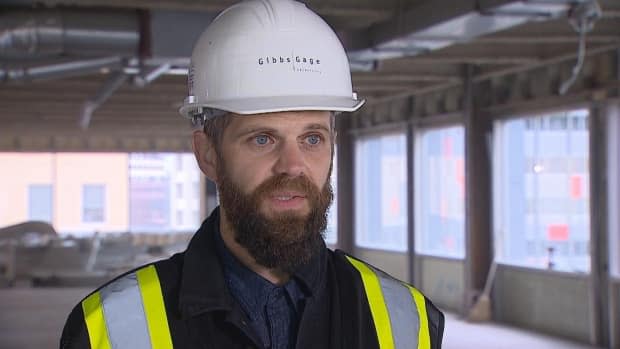What does the future hold for Calgary's empty office towers?

After a year-and-a-half out of the office, many Canadians aren't ready to go back — and they might not ever be ready.
The pandemic has left empty office towers across the country but perhaps no downtown core is quieter than Calgary's.
Roughly one-third of offices in the city's core have emptied out since the price of oil crashed in 2015.
A downtown vacancy rate above that number would be unprecedented in Canada, and one report has suggested it could climb as high as 34 per cent — which could be a North American record for a major city.
Nearly a decade ago, oil companies occupied nearly two-thirds of the city's downtown. Now they occupy half that number.
That exodus was only made worse as COVID-19 sent office workers home, fleeing tiny elevators and crowded conference room tables.
"People are trying to find where equilibrium is as far as work from home and work at the office," says Greg Kwong, a commercial real estate analyst in Canada's energy capital.
At least 10 buildings were more than 75 per cent vacant earlier this year, three of which were entirely empty.
Kwong said the downtown vacancy situation won't be fixed when the pandemic ends.
"We have got an oil business or an energy business that is severely depressed by lower oil prices," he said.
WATCH | Calgary looks to rethink its empty office towers:
But, when some of those workers do return, they might find a transformation underway.
If you ask architect Jonny Hehr, the city's downtown vacancy problem is actually rife with possibilities.
Hehr, with Gibbs Gage Architects, is behind a project to reimagine a former oil and gas office tower as low-income social housing — saving the structure and bringing more people into affordable homes downtown.
"We really have to rethink how we leverage the buildings and the infrastructure that we already have and turn it into the metropolitan city that Calgary always wants to be. To do that we have to have life in our downtown core after 5 o'clock," he said. "The adversity of it breeds creativity and if you don't have that problem then you don't have the creativity to solve it."

Thom Mahler, the head of the city's downtown strategy, said people are beginning to look at the vacancies differently.
"I think we have moved past the scary side in Calgary to the exciting side," Mahler said. "People are starting to look at it more as an opportunity … it's really changed from reactive to proactive."
Mahler said the city is eyeing a variety of options, from building out the residential market to looking at new industries that could use the buildings differently.
"There's a financial incentive with the property values coming down," Mahler said, for those looking to reimagine the spaces. "What we can do as a city is help facilitate that conversation … Calgary has an entrepreneurial nature, it doesn't take much to get those conversations going."
Multiple office towers are in the process of being converted into residential units. City council recently voted to help fund a project to transform the historic Barron Building into rental units, after the property development company ran into financial troubles.
Another historic red brick and sandstone building, which was formerly home to the Chamber of Commerce, has been taken over by SAIT for its new School for Advanced Digital Technology.
"If you think of a typical university campus, think of all the uses there … one of the advantages we have is our Plus-15 system," Mahler said, referring to the extensive network of raised, indoor pedestrian walkways connecting buildings in the city's core. "People can meet really quickly, really easily."

One slightly more unusual possibility could be vertical, urban farming.
Travis Kanellos with Ontario-based Elevate Farms says former towers could be turned into automated, multi-storey greenhouses that would allow for fruits and vegetables to be grown year-round.
"If you have office space that is dwindling from a usage standpoint and we can flip in some farm-equivalent product out of there, I think that is a pretty useful scenario," he said.
Mahler said urban agriculture could be a great way to bring fresh produce to downtown residents and local residents.
"It's a risky venture," he said. "You're probably going to need some kind of an incentive to make it work … [but] there are so many people that work and live in the area, that's probably your market."
Hehr said whatever happens, the main thing will be seeing a shift in how people think about downtown space.
"We're all social beings. When you come downtown, and all of a sudden these streets are hustling and bustling … it triggers a whole other idea of what your downtown can be and it starts to have knock-on effects of how we can transform spaces that maybe we'd forgotten because nobody had ever occupied them," he said.
"Now we have to look at them through a new light and think: what can these spaces be?"

 Yahoo Finance
Yahoo Finance 